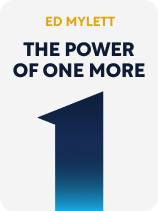

This article is an excerpt from the Shortform book guide to "The Power of One More" by Ed Mylett. Shortform has the world's best summaries and analyses of books you should be reading.
Like this article? Sign up for a free trial here.
Why do some people consistently achieve their dreams while others fall short? What’s the secret to turning aspirations into concrete accomplishments?
You can find practical strategies for transforming dreams into reality in The Power of One More by Ed Mylett. Goals propel you forward, and Mylett lays out an approach to goal achievement that combines peak performance techniques, habit formation, and discipline.
Read on to discover how to set powerful goals and develop the discipline to achieve them.
Ed Mylett on Goals
With the right mindset in place, the next step to going the extra mile is to translate your dreams into clear goals and actions. According to Ed Mylett, goals provide the energy and motivation to make dreams a reality.
To turn your dreams into inspiring goals, Mylett recommends you first get into a peak state, which is when your mind and body are working together harmoniously. You can reach this state by getting physically active. Physical activity releases hormones that energize you and boost your creativity, making you feel more motivated to set goals. Once you’re in a peak state, write down everything you want in life without holding yourself back.
(Shortform note: What exactly is a peak state? In Stealing Fire, Stephen Kotler and Jamie Wheal define peak states as altered states of consciousness. These states can be achieved not only through exercise, but also through psychedelics and simulation technology. In a peak state, you might feel like time slows down, your sense of self fades away, and you become incredibly focused and creative. You also notice details and connections you normally wouldn’t because activity in your prefrontal cortex decreases, allowing your unconscious mind to take over. As a result, you can tap into your deepest desires and dreams. Therefore, peak states put you in the ideal frame of mind for envisioning what you want in life.)
Mylett suggests you create a mix of short-term and long-term goals. An example of a short-term goal could be practicing a foreign language 15 minutes each day, while your long-term goal might be to hold simple conversations in that language in half a year. Make sure each goal is specific and has a strong reason behind it. For example, set an exact fitness milestone to reach by a certain date and understand why you want to reach that milestone. Also, experiment with ways to remind yourself of your goals regularly, such as getting an accountability partner, visualizing your goal, or repeating your goals aloud.
(Shortform note: Having a mix of short-term and long-term goals can be overwhelming—even if you have strong reasons for them and remind yourself of them regularly, it can still be hard to stay on top of all of them. In First Things First, Stephen R. Covey suggests a way to make goals more manageable and achievable: Create synergy among them. This means combining activities to accomplish multiple goals at once instead of dealing with each goal separately. For example, you could combine your fitness goals and reading goals together by listening to audiobooks while you run. You can even talk with family or housemates to find ways to coordinate activities and achieve everyone’s goals more effectively.)
Once you’ve set your goals, help yourself go the extra mile to achieve them by raising your standards, establishing supportive habits, and building your tolerance for doing hard things.
Raise Your Standards to Achieve Your Goals
Mylett contends that, to achieve your goals, you must develop high standards. He explains that goals are the outcomes you want, while standards are the levels of performance and behavior you maintain daily to get there. Standards should be clear and actionable. For example, if your goal is to get a promotion at work, your standards might include arriving 30 minutes early, volunteering for extra projects, and improving your skills through additional training. In contrast, a vague standard like “work harder” isn’t an effective stepping stone toward your goal.
Mylett writes that your life also mirrors the standards you accept. If you put up with a draining relationship, an unfulfilling job, or nagging health issues, you’ll keep getting more of the same. Raising your standards for yourself and for the people and situations in your life leads to positive change, even though it may feel tough at first.
| Be Wary of Perfectionism While high standards can help you make steady progress toward your goals, be careful they don’t veer into the territory of unhealthy perfectionism—which is when you set impossibly high standards for yourself. In The Gifts of Imperfection, Brené Brown says we often frame perfectionism as trying to be our best selves, but in reality, we’re just trying to control how others perceive us. It’s impossible to be or even appear perfect all of the time, which is why perfectionism can often lead to shame, stress, and depression. Similarly, while you shouldn’t tolerate low standards from others, avoid imposing unrealistic standards on them, too. This type of perfectionism, known as “other-oriented perfectionism,” is sometimes seen in parents who project their unrealistic expectations onto their kids. According to psychologists, people with this type of perfectionism often think of themselves as flawless while viewing others as defective. This attitude masks the perfectionist’s own insecurities. |
Establish Habits That Support Your Goals
In addition to raising your standards, writes Mylett, you should build positive habits that give you the consistency to achieve your goals over time. Your brain naturally creates habits to conserve energy, allowing you to perform routine tasks without much thought. Things like your morning routine, how you commute to work, and what you do to unwind in the evening are largely driven by ingrained habits rather than conscious decisions each time.
(Shortform note: Positive habits can be a powerful tool for achieving your goals because more than 40% of your daily behaviors are driven by habits. In The Power of Habit, Charles Duhigg elaborates on how habits save you mental energy: Without these automatic routines, you’d have to relearn everything you do every time you do it and make decisions every step of the way. For example, when you brush your teeth in the morning, you’d have to consciously decide how much toothpaste to use, how long to brush for, and so on, leaving less mental room to think of other things—like rehearsing a speech or brainstorming ideas for a novel.)
Mylett argues that good habits are more effective than bursts of motivation at carrying you through slumps and helping you achieve your goals. This is because when you face challenges and stress, your habits persist even if your motivation wanes. If you’ve developed good habits, like reviewing your to-do list first thing in the morning, they’ll keep you on track. But if you’ve developed bad habits, like procrastinating on your work, they’ll hold you back.
To form a new habit, create a trigger to start your new routine, do the action you want to make into a habit, and then reward yourself to lock in the habit. For example, if you want to start your day by reviewing your to-do list, you could use your morning coffee as your trigger, sit down and review your list as your action, and then treat yourself by listening to a short podcast or reading your favorite blog as your reward.
(Shortform note: In Atomic Habits, James Clear explains how you can invert the principles of habit formation to break your bad habits: Make the trigger invisible, the action difficult, and the reward unsatisfying. For example, if you want to stop snacking late at night, you could hide your snacks (make it invisible), keep your snacks in a hard-to-reach place (make it difficult), and imagine how sluggish you’ll feel the next day (make it unsatisfying). This way, you can not only create habits that support your goals, but also prevent yourself from falling back on the habits that undermine them.)
Build Your Tolerance for Doing Hard Things
Mylett writes that, to set and achieve ambitious goals, you must build your tolerance for discomfort. He argues that achieving anything extraordinary requires doing hard things and that few people build an exceptional career, business, or relationship by taking the easy path.
To build your tolerance for hard things, Mylett recommends you start each day by tackling your most challenging tasks first. This approach builds character and discipline and sets you apart from most people who gravitate to easy items on their to-do lists. Completing challenging tasks is more rewarding than completing easy ones because accomplishing these tasks expands your skills and raises your confidence in yourself.
(Shortform note: How challenging should a task be to help you build your tolerance for discomfort? In The Rise of Superman, Steven Kotler specifies that your task should be 4% more challenging than your skill level so you achieve flow—a state of deep, sustained focus in which you perform at your best and enjoy your task. Without this level of mental exertion, says Kotler, your brain won’t produce the chemicals that give you energy and focus, but it’s still doable enough that it won’t overwhelm you.)
Exercise: Set an Extra-Mile Goal
Mylett says that to go the extra mile, you must set clear goals and develop high standards and supportive habits to achieve them. In this exercise, choose one goal you want to achieve and create a plan to go the extra mile in pursuing it.
- Think of a meaningful goal you’d like to achieve in the next six months. What is this goal, and why is it important to you?
- What are three specific, actionable standards you can set for yourself to support achieving this goal? For example, if your goal is fitness-related, a standard might be “exercise for 45 minutes five days a week.”
- What’s one new habit you can develop that will help you consistently work toward this goal? How can you create a trigger, action, and reward system for this habit?
- How will you remind yourself of this goal regularly? Will you use visualization, an accountability partner, or another method?
- What’s one challenging task related to this goal that you can commit to tackling first thing in the morning? How might completing this task early in the day benefit your progress?

———End of Preview———
Like what you just read? Read the rest of the world's best book summary and analysis of Ed Mylett's "The Power of One More" at Shortform.
Here's what you'll find in our full The Power of One More summary:
- The power of an extra-mile mindset and how to adopt one
- Tips for building an inner circle of people who support your goals
- How to develop a tolerance for doing hard things






